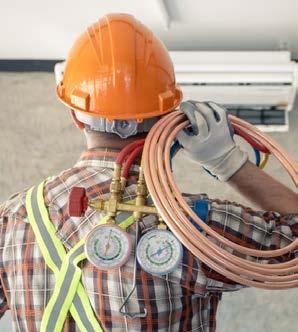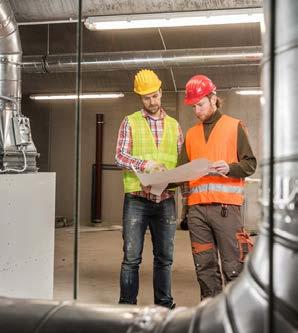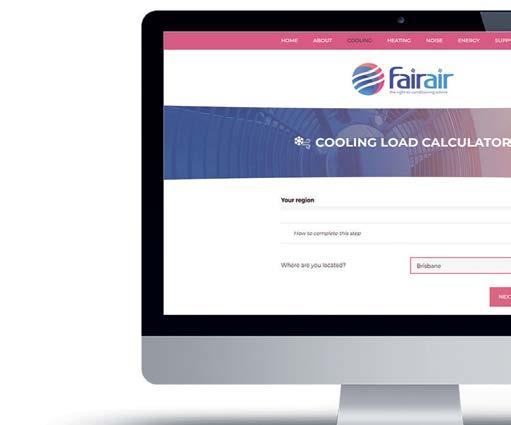
13 minute read
HVAC&R News regulars
MID-TIER HEROES
A trio of new studies reveal how Australia’s HVAC&R industry – and our much-neglected mid-tier buildings – can help us achieve our net zero aspirations. Louise Belfield reports.
Advertisement
According to the Australian Sustainable Built Environment Council (ASBEC), buildings in Australia make up about 19 per cent of total energy consumption and about 23 per cent of greenhouse gas emissions. And according to the Green Building Council of Australia (GBCA), commercial buildings account for 10 per cent of overall energy consumption, with commercial office buildings making up about 2.5 per cent.
Knowing the impact of the commercial building sector – and also that most of the energy we use in these buildings is used for cooling and heating – the next step is clearly to look at how we can improve the performance of our HVAC&R systems. In March 2021, a study funded by the Department of Industry, Science, Energy and Resources (DISER) and undertaken by the University of Wollongong (UOW) provided results of the largest national survey of facilities managers, HVAC contractors and associated design and systems specialists ever conducted. The question they wanted to answer was how the management and maintenance of HVAC in commercial office buildings impacts on their energy performance. The study focused on those directly responsible for this work in mid-tier commercial office buildings.
The resulting report, Better Ways to Work: HVAC Management, Repair & Maintenance in the Mid-Tier Commercial Office Sector (see HVAC&R Nation July 2021), was in response to a key initiative agreed to by all Commonwealth, state and territory energy ministers in 2019 to achieve zero energy and carbon-ready commercial and residential buildings in Australia by 2030.
TOWARDS ZEROENERGY BUILDINGS
The initiative, the Trajectory for Low Energy Buildings and its Addendum (the Trajectory) came out of the National Energy Productivity Plan. It was designed by a stakeholder reference group of 600 members representing energy consumers, the energy-efficiency sector, the building and property sector, the appliance and technology sector, the energy supply sector, gas suppliers, environmental organisations, energy consultants, universities, the Australian government, and state and territory governments.
The Trajectory outlines policies to deliver costeffective energy-efficiency improvements to homes and businesses with a view to lowering energy bills, contributing to energy security and affordability, reducing carbon emissions, improving people’s comfort and health, reducing wastage for the wider economy, and reducing pressure on the electricity grid.
These homes and business, however, make up only a fraction of our building stock.
“The real challenge in reducing energy consumption is with about 85 per cent of our buildings – those older, smaller, and poorer quality buildings that make up most of Australia’s office building stock – the ‘mid-tier’,” says Dr Dan Daly, project co-lead for the UOW study.
“The Better Ways to Work project has provided a significant new empirical data source on maintenance practices for this sector, as well as detailed commentary on the policy implications of the new data, to assist the federal government in tailoring policies to improve the performance of HVAC in the mid-tier.”
WHAT IS THE MID-TIER?
Mid-tier office buildings are generally defined as non-premium constructions. This is a sector that has been under-represented in energy upgrade activities to date, with little in the way of systematic data collection, says Daly.
“These buildings are often found in suburban and regional locations and have enormous potential for becoming more energy efficient. The Better Ways to Work project was commissioned to really get at some of the complexities of why we’re struggling to improve energy efficiency in this area.
“On paper, HVAC maintenance and upgrades have a very strong business case, but we also know that there are a lot of other factors impacting on lifting building energy efficiency – things such as work cultures and practices, owners not understanding the value of maintenance, regulatory complexity, as well as business models and established market ‘norms’ of lowest-cost contracting,” says Daly.
Any policies designed to improve the situation need to take all of this into account, he adds.
Consequently, the Addendum to the Trajectory for Low Energy Buildings – Existing Buildings, the second stage of the national plan, provides a suite of initiatives to do this.
These initiatives include developing information, training and energy rating tools for households and businesses to enable greater understanding of energy-efficiency options and applications, developing and expanding target building policies, and identifying and developing supporting measures.
BETTER WAYS TO WORK
IDENTIFYING COMMON ISSUES IN MID-TIER HVAC MAINTENANCE: COMMERCIAL OFFICES, AGED CARE, HOTELS AND SHOPPING CENTRES
AUGUST 2021
BETTER WAYS TO WORK
MAPPING DECISION-MAKING AND OPPORTUNITIES FOR IMPROVING ENERGY EFFICIENCY ACROSS THE MID-TIER HVAC MAINTENANCE LIFECYCLE
DECEMBER 2021
BETTER WAYS TO WORK
UNDERSTANDING THE BARRIERS TO SKILLS DEVELOPMENT FOR ENERGY EFFICIENCY IN COMMERCIAL BUILDING HVAC
JANUARY 2022


IDENTIFYING COMMON ISSUES IN MID-TIER HVAC MAINTENANCE: COMMERCIAL OFFICES, AGED CARE, HOTELS AND SHOPPING CENTRES
BETTER WAYS TO WORK || 1
MAPPING DECISION-MAKING AND OPPORTUNITIES FOR IMPROVING ENERGY EFFICIENCY ACROSS THE MID-TIER HVAC MAINTENANCE LIFECYCLE
BETTER WAYS TO WORK || 1
UNDERSTANDING THE BARRIERS TO SKILLS DEVELOPMENT FOR ENERGY EFFICIENCY IN COMMERCIAL BUILDING HVAC
BETTER WAYS TO WORK || 1

HOW THE STUDY WAS CONDUCTED
The UOW team brought together engineers and social scientists to design a project that could delve into the complex issues, Daly says.
“The resulting Better Ways to Work study looked at issues right across the maintenance and upgrade procurement cycle, as well as workforce and contractual concerns.”
The first step, in 2020, was a large survey that went out to HVAC contractors and facilities managers. More than 1,000 respondents provided solid data about what they see in buildings, and the barriers they face in achieving good maintenance, repair and retrofit work.
This was followed by a series of “deeper dives”, culminating in three final reports (shown above).
“We used industry interviews and targeted surveys to better understand the maintenance workflow and highlight where to target information programs, incentive schemes or regulation for maximum effect,” says Daly.
“We also considered the extent to which the issues identified in the mid-tier sector were present in other types of buildings, namely hotels, shopping centres and aged-care facilities. Finally, we looked at workforce issues that came out of the survey, and how government and industry could better support this workforce, which is going to be vital as Australia’s climate continues to change.”
THE THREE FINAL REPORTS
Ultimately, the team identified three areas for further investigation:
• Common HVAC maintenance issues across different mid-tier sectors: commercial office buildings, aged care, hotels and shopping centres
• Decision-making and opportunities for improving energy efficiency across the mid-tier HVAC maintenance lifecycle • Barriers to skills development for energy efficiency in commercial buildings.
“In designing the initial survey for the Better Ways to Work study we were very aware that HVAC technicians
BARRIERS TO BETTER MAINTENANCE
This report looked at decision-making across the HVAC maintenance life-cycle, and the issues that impact the quality of HVAC maintenance. The team prioritised 15 key issues, according to their impact on the quality of HVAC maintenance, how frequently the issues are encountered, and a significance ranking. These ranged from how job performance is judged (the evaluating maintenance performance phase) to perverse influences on design decisions (the design and installation phase).
1. Job performance is judged on a different timeframe (short) to the impacts of maintenance decisions (long), leading to short-term fixes
2. Upfront cost implications of repair or upgrade prioritised over life-cycle cost and system
3. Preventative maintenance contracts lack detail regarding expected standards, resulting in conflicting interpretations between contractor and client
4. The preventative maintenance market is highly competitive and cost driven, so it is delivered as a lowest cost service 5. FMs’ job performance is judged on budgets, not life-cycle performance, with potentially adverse impacts on the HVAC system
6. Budgets are often pre-determined before HVAC professional input, which rules out the best solutions
7. Split incentives for maintenance decisions, with tenants paying the cost of maintenance, but owners paying the cost of upgrades
8. Lack of consequences for malpractice 10. FMs are unable to provide appropriate maintenance oversight either due to lack of time, or skills and experience
11. Perverse incentives impacting maintenance decisions about whether to patch, repair or upgrade
12. Lack of time provided to understand HVAC systems in new buildings or new contracts
13. Lack of detailed project briefs or specifications, particularly in smaller buildings
14. Conflicting priorities between fixing performance or “fixing” complaints
The Original HVAC/R Press Fittings Still Stand Above The Rest!
A PROVEN TRACK RECORD
As the inventor of the original HVAC/R press fi ttings in 2015, RLS has a 5-7 year lead on every competitor – and more than 15 million fi ttings in service. That’s a track record you can trust, and one that no other company can match.

MORE THAN 15,000,000
fi ttings installed since 2015
360˚ METAL-TO-METAL CONNECTIONS
The patented RLS double circular press results in two 360˚ metal-to-metal connections. Our soft copper fi ttings are work hardened during the press, creating a permanent mechanical joint every time with no leak paths.
THE MOST COMPLETE PRODUCT LINE
While others max out at 1-1/8" or 1-3/8", we offer sizes up to 2-1/8" . Plus, with RLS-compatible jaws from RIDGID, Milwaukee and Milwaukee and Klauke, you can press our fi ttings with all major press tool brands.
Choose the faster, safer proven alternative to brazing!
Look for the fl are!
Contact Ian Robertson, Director of Sales, Australia and New Zealand, at irobertson@rapidlockingsystem.com or +61 419 460 785.
MADE IN USA
rapidlockingsystem.com.au
and FMs are busy, and would have limited time to respond to our questions,” says Dr Matthew Daly, the researcher leading the maintenance workflow stream.
“So, we kept the survey short and sharp, and were delighted by the very high response rate relative to previous mid-tier projects. This provided national context around the people, buildings and systems in this sector, and the relative importance of some of the key issues from previous work. We then designed a number of follow-up projects to dig into the detail of the responses that we received.
“Many of the participants kindly agreed to be contacted regarding their responses, and we had a fantastic opportunity to go back to survey respondents and talk to them in more detail about the maintenance procurement process. It also gave us an invaluable cohort of engaged respondents to test out our conclusions and recommendations in focus groups and targeted surveys.”
Dr Elyse Stanes, the researcher leading the skills and training stream, says they also took some of the findings and issues identified in the initial surveys and sought out other stakeholders to get new perspectives.
“Given the success of the initial survey, DISER were keen to understand the extent to which the findings might apply to other hard-to-engage sectors,” she says.
“Issues around skills and training were also highlighted from our survey, so we took a deeper dive into the skills, training and licensing of HVAC technicians around the country. “The HVAC workforce is crucial in improving energy efficiency in buildings, and also in electrification of many systems. There is a major societal transition already underway that will have HVAC technicians right at the frontline, and it is important that the training system is ready to equip the workforce with the skills needed.”
COMMON THEMES AND ISSUES
Dr Chantel Carr, project co-lead for Better Ways to Work, says all four reports are designed to stand alone; however, they do share common themes and issues, and together they give a comprehensive picture of the issues facing policymakers looking to target energy efficiency in the mid-tier. The Better Ways to Work report was the first of the series, released in 2021. It provides the high-level findings from the initial survey, and important context for the deeper dives.
The Identifying common issues in mid-tier HVAC maintenance report addresses the extent to which mid-tier issues are unique to the sector, or common across many types of commercial buildings.
“Most HVAC technicians work across multiple sectors,” says Carr, “so they were in a great position to compare and contrast.”
The Mapping decision-making and opportunities for improving energy efficiency across the mid-tier HVAC maintenance lifecycle report presents the findings of follow-up interviews, focus groups and surveys with HVAC technicians and FMs. These helped the team better understand maintenance workflows, and importantly, to identify the most critical issues and most promising policy solutions.
Finally, Understanding the barriers to skills development for energy efficiency in commercial building HVAC addresses fundamental questions about the HVAC&R workforce. It looks at the skills, knowledge and professional networks required to meet the federal government’s Trajectory for Low Energy Buildings. It also explores how to strengthen training and professional development pathways for those working on commercial buildings.
NEXT STEPS
With little existing work available in the academic or policy space dealing with the mid-tier, the UOW team is working to place the results in the context of global experiences of the energy transition, and to continue to build the case that maintenance is vital to decarbonisation, says Dr Dan Daly.
“We’ll be presenting the findings in many forums over the coming year, including ARBS 2022 and AIRAH’s the Future of HVAC Conference, and will be very interested in industry feedback.
“We’ll also be actively working to ensure the important issues raised through Better Ways to Work continue to be considered by the incoming federal government.” ■
BEYOND COMMERCIAL OFFICES
To assess the similarities and differences between commercial buildings and other sectors, this study conducted: • A review of relevant literature for aged care, hotels and shopping centres • Interviews with sector experts and professionals • Focus groups with HVAC and facilities management professionals in these sectors. Aged-care facilities: Based on the finding from interviews, there are many differences between aged-care facilities and mid-tier commercial office buildings. The interviews in all cases focused on residential aged care facilities, and although village-type facilities are common, these sites typically use residential air conditioning systems and are substantively different to the commercial sector. Hotels: The hotels sector is diverse in terms of size, building type and ownership profile. Because motels and small hotels typically use domestic air conditioning systems, discussion focused on larger hotels. These appear to operate in a relatively similar manner to the office sector, using similar HVAC equipment and building stock. Typical HVAC configurations include a central chilled water plant with fan coil units serving individual rooms, although there were many examples of the use of packaged units or split systems, even in large hotels. Shopping centres: Interviews with sector stakeholders suggest that many of the issues identified in the mid-tier office sector will likely also exist in the shopping centres space, albeit only in certain shopping centres. The sector appears similar to the office sector, in that there is a large diversity of building stock, system quality, and ownership types. ■
BUILDING THE SKILLS
This study identified seven key skills development issues as barriers to delivering on energy transitions in the built environment:
1. Attraction, retention and attrition of
HVAC contractors
2. The professionalisation of facilities managers
3. Inflexible VET training regimes for HVAC contractors
4. Limited capacity for responding to new technologies for HVAC contractors and facilities managers
5. Misalignment of routine tasks with skill levels of HVAC contractors
6. Lack of recognition for soft skills for HVAC contractors and facilities managers
7. Complex regulatory environment across states for HVAC contractors.
The report also provided a framework for improving skills development:
1. Shaping a workforce on the frontline of energy transitions in the built environment via:
• Working with industry to develop a workforce attraction strategy
• Government and industry support for workforce retention.
2. Enhancing capacity for skills and training to meet the Trajectory for Low
Energy Buildings by:
• Supporting upskilling to keep pace with new technologies and information
• Broadening the remit of energy-efficiency training to include soft skills.
3. Supporting the development of skills and training through a multi-scalar, cross-sectoral approach by:
• Recognising diverse ways of acquiring skills and knowledge to deliver a future-focused workforce
• Developing a training eco-system approach to skills development for energy efficiency. ■
To read the main Better Ways to Work report and three other reports, go to betterwaystowork.com.au












